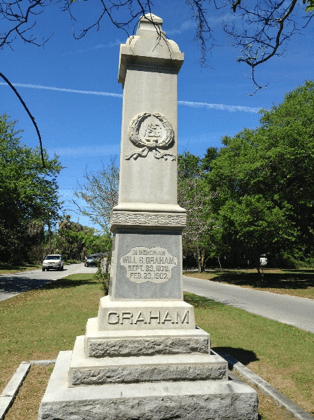February 21, 2020
More than 100 years ago, Will S. Graham served as the acting chief of the Delgar Reel Squad in Sumter. While fighting a fire, he was injured by a falling wall. The next day, Feb. 23, 1907, he succumbed to his injuries, becoming Sumter County’s first recorded line of duty death. Much of his personal life is unknown. It is believed he lived with his parents, Col. James DuPre Graham and Georgiana Sanders Graham, on Liberty Street. He had five siblings, including three sisters and two brothers. Research reveals, in 1895, Graham was working as the Delgar Reel Squad foreman. While doing so the local newspaper of the day, the Watchman and Southron, reported a fire occurred at a local unnamed restaurant. The weather conditions in the Jan. 2, 1895, issue describe the frigid conditions he, and his fellow “firemen,” had to endure.
“Despite the snow and ice, the Sumter Fire Department responded promptly and extinguished the fire. Delgar No. 3 Reel Squad got first water on the fire…It was tough work for the firemen fighting the fire in the cold and getting soaked with the water, which froze as soon as it struck them. Some of the firemen’s clothing were solid mass of ice and the cold must have been intense. The Sumter Fire Department had a splendid opportunity to test their grit under trying circumstances, but as was fully expected of them they proved themselves fully equal to the occasion. Hurrah for Sumter’s wide awake and brave firemen.”
Six years later, in 1901, a large fire endangered the entire town. The early evening fire started in the mule shed of Epperson’s stables on Canal Street, “marking the sixth time Mr. Epperson had been burned out,” and the “fire spread like a tornado.” (The Manning Times, Mar. 20, 1901). Destroyed were 19 buildings - including the new county jail. On that day, “the winds were high and the buildings several blocks away were fired. The entire city was threatened at one time.” (Watchman and Southron, Mar. 20, 1901) By midnight, the fire was under control. However, the firemen worked so close to the flames that, “Several sections of fine fabric fire hose attached to the plug near the burning buildings were destroyed, the heat becoming so intense that the fireman had to flee for safety.” (The Bamberg Herald, Mar. 21, 1901) Beck Block Fire During the early morning hours of Friday, Feb. 22, 1907, Chief Graham fought his last fire. The Watchman and Southron stated he was, “fearfully injured at the Beck Block fire.” The newspaper described the response, accident, and victims.
“The fire department and many citizens responded promptly to the alarm. They were doing laudable work in checking the flames, when a crash came and the walls of the front fell forward and in an instant lay in piles of debris extending half way across the street. Four men were caught beneath the falling wreck of stone and mortar.”
The four men injured beneath the “wreck of stone and mortar” included Chief Graham. As he was ascending the ladder on the side of the building, the walls collapsed.
“He was hurled violently to the pavement and completely buried in the debris. That he was not instantly killed is marvelous. He was carried to the Mood-Osteen infirmary in an unconscious condition where he lingered until the next morning.
Chief Graham’s injuries included several scalp wounds “with symptoms of injury to the brain,” a compound fracture of the leg at the knee and just above the ankle, two broken fingers, a broken upper jaw, and severe bruises on his face.

It also revealed how, even while unconscious at the infirmary, he physically responded to hearing the “first stroke of the fire alarm bell” sound. The following morning, Chief Graham succumbed to his injuries. He was 34 years old. Sunday Suits Graham’s “simple but impressive” funeral took place the following Sunday at 1 p.m. at the First Baptist Church. It “was a striking testimonial to the popularity of the deceased, for despite the downpour of rain and the freezing temperature the church was crowded to the doors and many could not gain admission.” (Watchman and Southron, Feb. 27, 1907) The members of the Delgar Reel Squad served as pallbearers. His casket was taken from the church to the cemetery in the Delgar hose wagon. His final resting place is in the Sumter Cemetery, on West Oakland Avenue, alongside his parents.

Ironically, as the firemen were returning from burying Chief Graham, a fire was reported. The baggage room of the Atlantic Coast Line Station depot was ablaze. “The department promptly responded to the call and despite the raw, rainy weather, battled with the flames practically the entire afternoon,” the newspaper said. Nearly 10 pouches of U.S. mail were destroyed, along with “many pieces of baggage.” No firemen were injured that day and, “Save the discomfort of wet clothing, the extreme cold weather, and ruining of many Sunday suits, the firemen came out of the incident unscathed,” the newspaper reported. An article, printed beside the story of his burial, reminded readers of the need for fire escapes as so many people are “exposed to frequently occurring fires.” (Watchman and Southron, Feb. 27, 1907)

Carved in Granite
Soon after Chief Graham’s untimely death the bereaved citizens of Sumter, along with the members of the Delgar Reel Squad, erected a memorial. Since then, every day in Sumter, hundreds of cars pass by a monolithic monument sitting in the median near the corner of Warren and North Main Street. The following words are inscribed:
In Memoriam Will S. Graham Sept. 23, 1872 Feb. 23, 1907

Photo courtesy of Chief Carter Jones
On the other three sides, the following is written:
Thus, on this day - the 113th anniversary of his death - we remember Chief Will S. Graham.
 Back to Firewire
Next Post
Back to Firewire
Next Post
